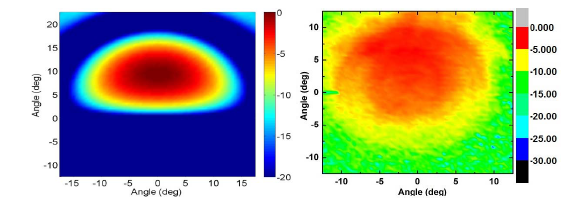Researchers led by Prof. Sheng-Cai Shi, Purple Mountain Observatory, Chinese Academy of Sciences, report on the investigation of a 3.7 THz phase-matched third-order distributed feedback (DFB) quantum cascade laser (QCL) as the local oscillator (LO) of a superconducting hot electron bolometer (HEB) heterodyne receiver. Exploring the terahertz (THz) frequency range is of particular importance for many research fields such as astrophysics and atmospheric science since this frequency range holds a large number of fine structure and molecular lines providing important information of fundamental astrophysical and atmospheric processes. At frequencies above 1.5 THz, superconducting hot electron bolometer (HEB) mixers are commonly used and have been demonstrated with a superior sensitivity up to 5.3 THz. However, the lack of suitable LO sources at frequencies above 2 THz seriously limits practical applications of superconducting HEB mixers. 
BY with ZHANG Wen Fig. Calculated (left) and measured (right) beam pattern of the third-order DFB QCL. Due to the incorporation of the third-order Bragg gratings, the beam pattern of the QCL was found much improved. Beam pattern measurements show that the QCL has a narrow beam with ~12×18 degree divergence, which is in good agreement with simulations by considering the gratings as an array of phased linear sources. Using this QCL as LO, we measured the noise temperature of a log-spiral antenna coupled superconducting HEB mixer at 3.7 THz. The lowest double-sideband (DSB) receiver noise temperature is about 4000 K, and reduced to 1100 K after correcting the optical losses. This result shows that phase-matched third-order DFB QCLs are very promising device as a LO in THz heterodyne receivers. The work by W. Miao, W. Zhang, Z. Lou, Y. Ren, S.L. Li, K. Zhang, Q. J. Yao, T.Y. Kao, Q. Hu, and S. C. Shi (corresponding author), accepted by General Assembly and scientific symposium (URSI GASS), has been published online ( http://ieeexplore.ieee.org/xpl/freeabs_all.jsp?arnumber=6930015&abstractAccess=no&userType=inst). |
